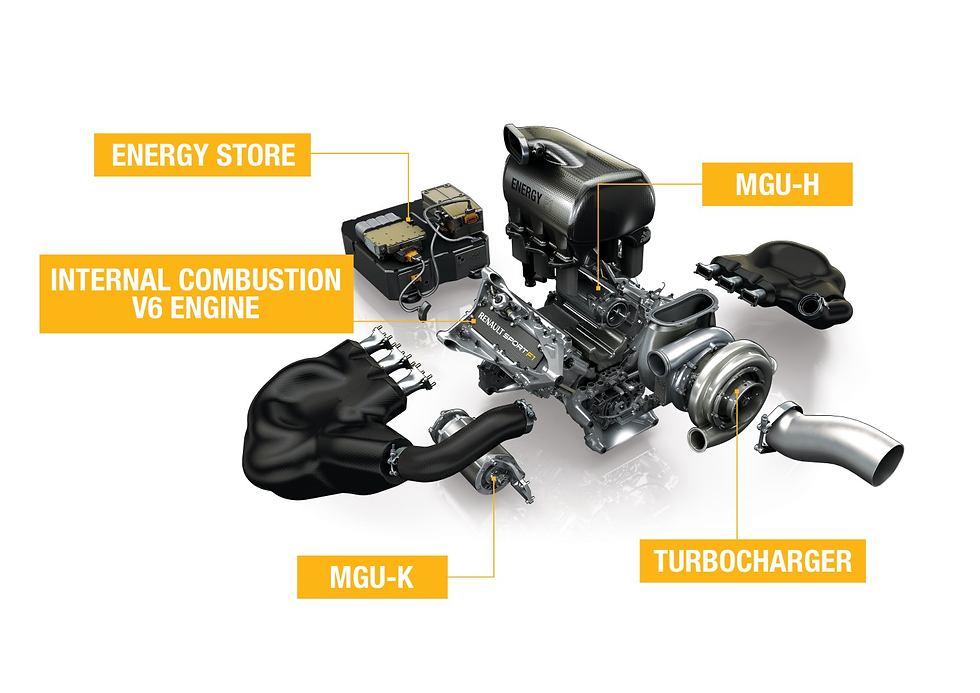F1's beating heart: Your guide to the 2025 power unit
- Poppy Evans
- Feb 10
- 4 min read
Updated: Feb 12
Written by Poppy Evans, Edited by Umut Yelbaşı
You may be thinking, “Isn't a Formula One car's power unit just the engine?” Well, no - an F1 car's power unit is not just an engine but rather a more complex yet crucial aspect of the car. Think of it as the beating heart of the car: without it there is simply no life. No matter how good the rest of the car is, it would all be pointless without its heart.

How does it work?
The power unit is composed of the Internal Combustion Engine (I.C.E), the Motor Generator Unit - Heat (MGU-H), the Motor Generator Unit - Kinetic (MGU-K), turbocharger, energy store, control electronics and an exhaust.
The Internal Combustion Engine and the rest of the components come together to form the ‘power unit’ - which became a hybrid system in 2014, meaning it is structured not just as an I.C.E. but functions with electric motors and an electric recovery system (ERS) as well.

Each season the teams are allocated a certain number of each of these components. If they use more of the components than their allocated limit, then the car that used the extra component will be penalised with a 10 place grid penalty for their first violation, and an extra five places for each violation after the first.
If this places the driver past 15th on the grid, then they are automatically placed at the back of the grid in last position.
Why is there a limit to the number of components used?
Simply, the cap on new component usage is enforced as both a cost saving measure and to make the sport more economical. Prior to this rule addition, teams would change the units many times which cost money, time and resources.
What does each component actually do?
Every component of the power unit is crucial in ensuring the car can function effectively, efficiently and, ultimately, quickly! A failure of the power unit is like the beating heart of the car getting heart disease and, as you can guess, the car will only deteriorate from here.
Here’s a brief description of some of the key aspects of the power unit:
I.C.E. - The main component of the power unit, creating most of the power. Effectively, it is a cylinder containing a piston that moves down and up, down and up in four strokes. As the piston lowers to do this, an air and fuel mixture enters the cylinder which becomes compressed when the piston lifts up again, creating an increase in pressure.
A spark is added to ignite the mixture forcing down the piston which drives the movement of the crankshaft which ultimately turns the wheels of the car. This occurs in just one cylinder, each car has six cylinders which forms the 1.6 litre, V6 engine.
MGU-K - Connected to the left of the I.C.E. and onto the crankshaft. When the car decelerates, a spinning electric motor captures kinetic energy, which is then converted into electric energy, which charges the battery, adding more horsepower on top of the power from the I.C.E.
MGU-H - The MGU-H is an electric motor sitting next to the turbocharger, although it will be banned in 2026 mainly due to its cost inefficiency. One use of the MGU-H is to reduce turbo lag (the delay in response from the driver putting their foot on the accelerator to receiving that boost from the turbo).
It also produces electricity as sometimes the boost created by the turbo is too much for the engine to handle. Exhaust gases enter the MGU-H to slow down the turbo and reduce the boost back to the required level for the car. The MGU-H uses the excess energy from the exhaust gasses to power the battery and MGU-K.
Turbocharger - Spinning up to 150,000 revolutions per minute (RPM), the turbocharger contributes to the overall power the power unit provides.
The turbo uses exhaust gases produced by the I.C.E. to spin a turbine (you can think of this as a hamster wheel) where it collects waste energy from the exhaust and transforms it into useful energy, which moves through the turbocharger into the compressor.
The compressor takes in atmospheric air and compresses it to be pushed into the I.C.E. cylinder as mentioned above.

How do F1 teams get their power units?
Some teams build their own power units, while others purchase theirs from suppliers. If the team decides to become a power unit manufacturer, then the engine must be built in line with FIA regulations.
Currently there are four power unit manufacturers: Mercedes, Ferrari, Honda and Renault. In 2026, there will be two new additions to the list in Ford, who will be teaming up with Red Bull Powertrains, and Audi.
What’s the future looking like for power units within F1?
2026 will see major changes to the power units with increased sustainability with fully sustainable fuels, more power (an additional 120 horsepower), and consequently higher acceleration around corners. These are just a few of the changes to come in line with a new generation of F1 cars. It is all getting very exciting, and this is just the beginning.









Komentáře